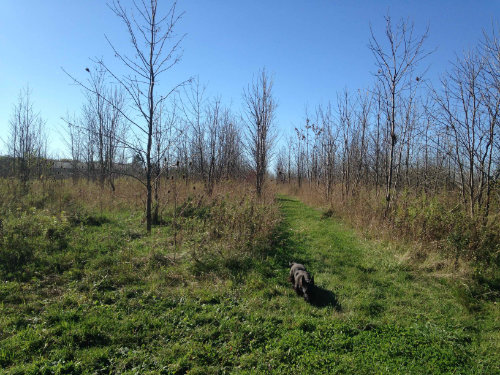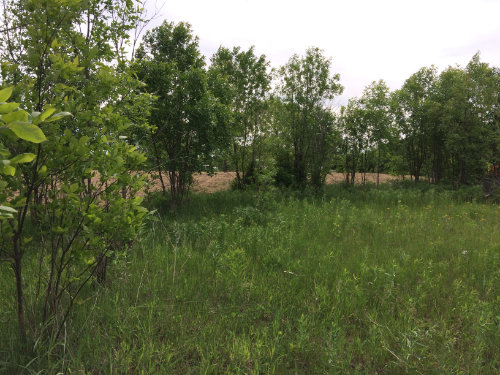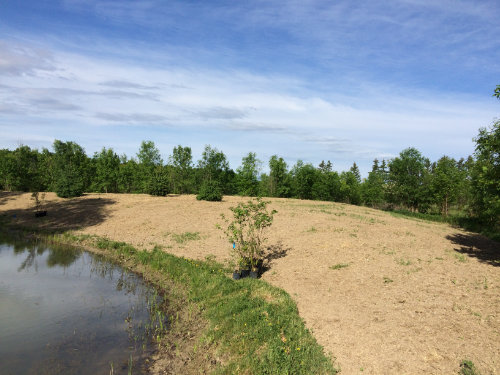When Rebecca and Rick Fish purchased their rural property on the banks of the East Sydenham River near Sombra in 1989, it consisted of 55 acres of farmland. They had looked high and low for a wooded property but hadn’t managed to find one, so they set out to naturalize various areas of the property over time.
In 1991, Rebecca and Rick retired the northern half of their property from agricultural production. In 1992 the St. Clair Region Conservation Authority planted 20 acres with Green Ash. The saplings were densely planted one meter apart in rows about two meters apart. Unfortunately, due to a subsequent infestation by the invasive insect known as the emerald ash borer, the ash trees never matured and remained stunted at about 10ft high, in shrub-like form.

Before - Pre-project Ash Planting - K Pickett
When Rebecca and Rick joined the Landowner Leaders program in February 2016, their top priority for habitat rehabilitation was the Green Ash plantation. The site is on clay soil and the understory was mainly non-native grass. They were supportive of the suggestion to replace the plantation with thicket habitat, an increasingly rare habitat type in southern Ontario due to fire suppression and land conversion. Thicket habitat is an important component of the Carolinian Life Zone because it provides unique habitat features for species that require habitat with more structure than a meadow, but with less tree cover than woodlands.
More specifically, the site was perfect trial ground for creating thicket habitat for the endangered Yellow-Breasted Chat, given its relative proximity to Point Pelee National Park where the species can still be found. In addition, the ash could be used to structurally support native vines, a key habitat component for the species. Rebecca and Rick were excited at the thought of contributing to research on the species by way of this experimental habitat creation project, knowing that whether it was successful in attracting the species or not, the area would become a diverse native Carolinian thicket ecosystem.

Affter - Edge of Thinned Area - K Pickett
Informed by a similar initiative under way at Point Pelee National Park, CCC ecologist Karolyne Pickett developed a plan to create 10 acres of thicket habitat on the western half of the plantation, in collaboration with Rachel Voros of Quiet Nature Ltd., a natural landscaping company based in Ayr, Ontario. The plan consisted of mechanically removing the ash, followed by planting of appropriate native species for the clay soil site. The area identified for thicket habitat was mapped out and the ash trees within it were mechanically cut near the base. Mechanical removal took place in January 2018 to avoid impacts on wildlife. The woody debris was gathered into large brush piles to provide nesting habitat for snakes, thus complementing the snake hibernaculum constructed on the property in the fall of 2017.
In the spring of 2018, 380 shrubs were planted in the cleared area. Nineteen species were chosen based on the geographic location of site, soil type, and availability at nurseries, including three species of native roses thought to be key features of Yellow-breasted Chat habitat. The centre of the thicket habitat pocket was left open. Two species of native vines (Riverbank Grape, Virginia Creeper) were planted near the brush piles and along the open area’s edges. Because biodiversity of herbaceous cover was low across the site (and mainly consisted of non-native grass), re-establishing native vegetation was part of the plan to attract a greater variety of insects to supply the insectivorous needs of the Chat. To this end, the existing grassy area adjacent to a large pond was tilled and seeded with a mix of over 14 species of native prairie plants, including Little Bluestem and goldenrods.
The planting is now complete. With support from the landowners and volunteer birders, CCC will monitor the survival of the plantings and conduct surveys to document avian diversity and abundance over time. Stay tuned!

Parie Seed Planting - K Pickett
